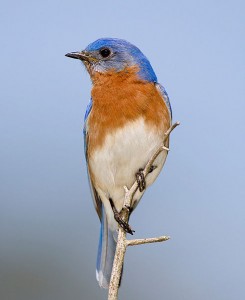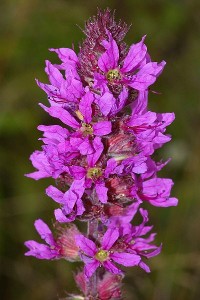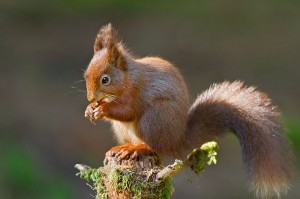Guest post by Dan Kraus, Nature Conservancy of Canada
Somewhere in the rivers of southern Ontario is a species few people have heard of, and even fewer have ever seen. It’s simply named the rainbow. The rainbow is a freshwater clam that gets its name from the rich iridescent colours on its shell. It’s so colourful that people once used the shells for jewelry. Like many other freshwater clams, it has an almost unbelievable lifecycle where it recruits fish to disperse its young by grabbing them by the head and injecting tiny baby clams into their gills. The rainbow is particularly ingenious at this, and uses a lure that looks like a delicious crayfish to attract the unsuspecting host to ferry its young to new homes.

The rainbow clam (Photo Karen Little, Illinois State University).
The rainbow was once widely distributed and common in many rivers and creeks in southern Ontario. Today it is extremely rare. While we played a part in obliterating the rainbow by polluting its river home, today the number one threat to this species is the invasive, non-native zebra mussel.
Zebra mussels arrived in the Great Lakes region in the late 1980s in ballast water dumped from a freighter that started its journey in the Black or Caspian Sea. Within a decade, zebra mussels had spread throughout the Great Lakes and many of its tributaries, and they continue to make their way west in bait buckets and on boats. One dump of ballast water changed the fate of the rainbow, along with hundreds of other native plants and animals – and the people of the Great Lakes region – forever.
The story of the rainbow is the story of thousands of species from around the world. While habitat loss is still the number one threat to the abundance and diversity of nature, invasive species have rapidly become the second largest issue. In many cases, the combination of habitat loss and invasive species is proving too much for many native plants and animals (it’s like someone messing up your room, and then deciding to stay with you). Nature Conservancy of Canada (NCC) and other groups that manage land and waters for native species have become vigilant for new invasive species while managing those that are already established. At NCC, invasive species management is identified as a priority action on almost all nature reserves across southern Canada.
Invasive species are animals, plants, and even diseases from one place that are transported to another place by people. Sometimes we do this intentionally, like bringing European starlings to North America in celebration of the birds mentioned in the works of William Shakespeare. Other intentional introductions (or species that escaped) include purple loosestrife, Russian olive, common carp and Norway maple. Often, the newcomers die out in this foreign land, or persist at low numbers that have almost no impact on indigenous plants and animals. In other cases, such as zebra mussels and European starlings, these non-native species can explode in numbers and come to dominate native habitats, freed from the diseases, predators, and competitors of their homeland. European starlings are now one of the most abundant birds in North America, and aggressively evict other cavity-nesting birds such as eastern bluebirds, northern flickers, and tree swallows.

The European starling (Sturnus vulgaris) has been included in the International Union for Conservation of Nature (IUCN) list of top 100 worst invasive species (Photo: Pierre Selim).

Eastern blue bird (Sialia sialis) is among the native species that is being threatened by invasive European starlings (Photo: William H. Majoros).

Purple loosestrife (Lythrum salicaria) (Photo: Christian Fischer).
Often introductions are unintended, as species hitchhike on our goods and transport. Though this includes some mammals like Norway rats (which are actually from China), invasive species are mainly composed of weedy plants and diseases. For example, no one intended to bring chestnut blight to North America in the early 1900s, it just came along with some Japanese chestnuts that were imported for a garden. Unfortunately, while the Japanese chestnuts had co-existed with chestnut blight for thousands of years and weren’t seriously impacted by this disease, our North American chestnuts had no resistance, and the magnificent tree that once dominated more than 80 million hectares of eastern forests was reduced to a handful of individuals.
Every one of our planet’s habitats is susceptible to new species wreaking havoc when they arrive unannounced. Indeed, we Canadians have sent our own ecological party-crashers to all corners of the Earth. Canada goldenrod is spreading rapidly across China, causing extinction of rare plants. Grey squirrels are out-competing native red squirrels in England and yes, even our beloved beaver is despised in Argentina and Chile, where it threatens more than 16 million hectares of native forest. While these species are well behaved at home, when they leave our borders they are freed of their natural regulators and become invasive.

Red squirrels (Sciurus vulgaris) in England are being out-competed by North American grey squirrels (Sciurus carolinensis) (Photo: Paul Whippey).
The good news is that we have learned some hard lessons from our ecological monkey-wrenching – including the economic costs. A recent report estimates that invasive species cost more than $30 billion a year; a figure that surpasses the spending on healthcare in BC and Alberta, combined. This is a combined estimate of costs to Canadian forests, lakes and agriculture. There is also rising concern about losing the richness and uniqueness of local biodiversity to these adaptable generalists that are spreading across Canada.
Governments are responding through better inspections of goods and transport coming into Canada. Most provinces now have coalitions that are building awareness about invasive plants. Parks and protected areas are being managed to keep new invaders out and limit the impact of those we already have. Gardeners are increasingly requesting native plants, and nurseries are no longer selling some of the worst invaders.
Most Canadians may never see the rainbow, eastern bluebird, American chestnut, or many of our other plants and animals that are giving in to the growing pressure of invasive species. But with each piece of Canada’s nature that slips away, it seems that we are losing an opportunity. Whether an economic opportunity, or an opportunity to experience healthy and intact ecosystems and opportunities for enjoyment and wonder about the richness and diversity of Canada’s plants and animals, invasive species must be managed.
About the author
Dan Kraus is the Manager of Conservation Science and Planning for the Nature Conservancy of Canada – Ontario Region. He has worked on species conservation projects ranging from population studies of snakes on Pelee Island to preparing the provincial recovery strategy for Ontario’s Polar Bears. He is involved in a wide diversity of conservation planning initiatives and has been guiding the application of the Great Lakes Conservation Blueprint for the last ten years.






One thought on “The end of the rainbow: Invasive species and the real costs of ecological monkey-wrenching”
Comments are closed.